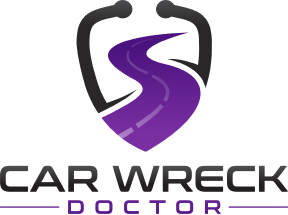What is Whiplash?
Whiplash is one of the most prevalent soft tissue injuries sustained in automobile accidents. They develop when the head is violently jerked back and forth, causing damage to the neck muscles and ligaments. Whiplash symptoms can vary from mild to severe, impacting a person's quality of life significantly and could lead to long term pain. If you have recently been involved in a car accident, you may have developed a whiplash injury. In order to avoid lasting pain, it is critical that you receive treatment immediately. Contact Car Wreck Doctor today to be put in touch with the best car accident chiropractor available. In this blog article, we will look at the various symptoms and treatment options for a whiplash neck injury caused by a car accident.
Before treatment can commence, a whiplash diagnosis must be made by a medical care professional. A doctor will typically perform a physical examination to look for indications of injury such as tenderness, swelling, and limited range of motion. To corroborate the diagnosis of a whiplash-associated disorder and rule out any other underlying conditions, X-rays, CT scans, or MRI (Magnetic Resonance Imaging) scans may be used. Early treatment of a whiplash injury may reduce chances of developing chronic pain in the future.
Common Symptoms of Whiplash
Put basically, a whiplash injury is a neck injury, but the symptoms can range from muscle weakness to psychological factors. The following is a brief list of the most common whiplash clinical symptoms one may experience.
Neck Pain
Neck pain and stiffness are the most prevalent whiplash symptoms. This pain can be sharp and strong or dull and achy. It is also possible for it to spread and manifest as shoulder pain, limb pain, and back pain. The stiffness can make moving the neck difficult and may restrict the individual's range of motion.
Headaches
Individuals suffering from whiplash may experience headaches in addition to neck discomfort and stiffness. These headaches can range in severity from mild to intense and can last for hours or days. They could be near the base of the cranium or behind the eyes.
Dizziness
Dizziness is another result of an acute whiplash injury. It may feel like you're spinning or losing your equilibrium. It is possible that it will be followed by nausea or vomiting.
Numbness
Whiplash patients may also feel tingling, numbness, or even muscle weakness in their arms or hands. Pressure on the muscles in the neck causes this.
Fatigue
Fatigue, trouble sleeping, sleep disturbances and irritability are also symptoms of whiplash. The stress of the injury and the pain associated with it can produce these symptoms.
If you experience any of these symptoms following an injury, you should seek medical treatment right away. A doctor can conduct a physical exam and make treatment recommendations to help manage your symptoms and encourage healing. Depending on the severity of the injury, treatments may include medication, physical rehabilitation, or other interventions.
Treatment Alternatives
Whiplash injuries are treated differently based on the severity of the injury and the individual's symptoms. Here are some of the most prevalent whiplash treatment options:
Ice and Rest
It is critical to rest and apply ice to the affected region in the early phases of a whiplash injury to reduce swelling and pain. Resting the neck can also aid in the prevention of further harm and the promotion of healing.
Medication
Pain and irritation can be reduced with over-the-counter pain relievers such as ibuprofen or acetaminophen. If the pain is severe, a doctor may recommend stronger pain medication or muscle relaxants.
Rehabilitation Therapy
Whiplash injuries can be effectively treated with physical rehabilitation. A physical therapist can help the person strengthen muscle weakness and increase range of motion after a neck strain. They may also employ methods such as massage, heat therapy, electrical nerve stimulation and stretching exercises to alleviate pain and increase mobility.
Chiropractic treatment entails manipulating the spine to alleviate pain and increase mobility. While some individuals benefit from this treatment, others may not see any improvement.
Injection Treatment
Injection therapy entails injecting a local anesthetic or steroid into the affected region to alleviate pain and inflammation. This treatment is usually used only when other treatments have been ineffective.
Surgery
Surgery is typically reserved as a last option for severe whiplash cases due to the various risk factors. It may be required if the spinal cord has been damaged or if the person is experiencing significant pain or neurological symptoms.
Whiplash Prevention
While whiplash injuries cannot always be avoided, such as occurrences resulting from a sports injury there are some precautions that can be done to reduce the risk of injury in a car accident. These are some examples:
Using a Seatbelt
Wearing a seatbelt can help to reduce the amount of movement the body makes during a collision, which can serve to prevent whiplash injuries.
Headrest Adjustment
In a vehicle, the headrest should be adjusted so that it is level with the back of the head. During a collision, this can assist to keep the head from being jerked back and forth.
Driving Caution
Driving safely and following traffic rules can help to lower the likelihood of a car accident occurring in the first place.
Seeking Immediate Medical Attention If you have been in a car accident, it is critical that you seek immediate medical attention, even if you do not initially experience any signs of injury. Whiplash injuries can take several days to manifest, and delaying care can exacerbate the injury.
Treat Your Whiplash with Car Wreck Doctor
While whiplash injuries cannot always be avoided, taking measures such as wearing a seatbelt, adjusting the headrest, driving carefully, and seeking quick medical attention can help reduce the risk of injury.
It is critical to understand that not all whiplash injuries are the same, and the severity of the injury can differ from person to person. Mild whiplash cases may recover on their own after a few weeks, whereas more severe cases may result in more severe pain and require more intensive treatment and take longer to heal your ongoing pain. To put it simply, recovery time may vary.
It is also critical to adhere to your healthcare provider's therapy plan and not rush the healing process, this may result in more persistent pain. Returning to normal activities too soon may cause the injury to worsen, resulting in a longer recovery period.
To summarize, whiplash injuries caused by vehicle accidents can result in severe pain and disruptive to a person's life. There are, however, a number of treatment choices available to help manage symptoms and promote healing. Taking measures to reduce the risk of injury, getting prompt medical attention, and dealing with the emotional and psychological consequences of the injury are all essential steps in the recovery process. If you have recently suffered from a car accident, it is critical that you receive treatment as soon as possible. Reach out to Car Wreck Doctor today to learn how they can work to relieve your pain.





